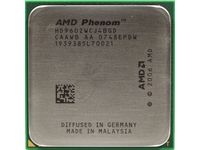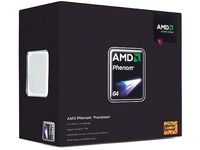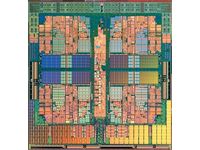Updated CPU Charts 2008: AMD Versus Intel
AMD: Still Playing Catch-Up
AMD is not having an easy year. This is partly due to the troubled Phenom introduction and its TLB issues, but also to the strength of the company’s principal competitor Intel, which holds an advantage in process technology and continues to do well with its Core micro-architecture. With the new Phenom XX50 series, the TLB error has been resolved, but some of the other issues remain.
The processor architecture seems to be having a hard time achieving higher clock speeds, which are absolutely necessary in order to keep up with Intel. The fastest processor model from AMD is the Phenom X4 9950 at 2.60 GHz. Although it’s a strong offering, AMD has had to slash the prices on even its fastest desktop chips in order to compete. Those CPUs are now so inexpensive that the top models are on a par with Intel’s mid-class products.
Since AMD is still manufacturing at 65 nanometers, ramping up clock speed is having a significant effect on the power consumption of its CPUs. The 2.50 GHz clocked quad-core Phenom X4 9850 operates with a maximum power requirement of 125 watts. The Phenom X4 9950 clocked just 100 MHz faster requires as much as 140 watts. Not every motherboard can be used with this chip, since the load on the voltage regulator is pretty high.
AMD is the first manufacturer to offer something between dual-core and a quad-core processors, and its Phenom X3 includes a sometimes-awkward three cores. The Phenom X3 8750 at 2.40 GHz is the fastest model from this family.
In terms of energy efficiency, AMD has an ace up its sleeve: thePhenom X4 9350e is the most energy-efficient quad core processor, with the 2.00 GHz model getting by on just 65 watts.
Since AMD isn’t refreshing the top of its product lineup very often, the company is instead producing ’new’ processors for the Athlon X2 and e series. The most recently introduced Athlon X2 model is the 6500 Black Edition, which is the first dual-core Athlon to be based on the Phenom core. It sports a 2.30 GHz clock speed.
Get Tom's Hardware's best news and in-depth reviews, straight to your inbox.
Current page: AMD: Still Playing Catch-Up
Prev Page Intel: Takes The Performance Crown Next Page CPU Tables For AMD And IntelTom's Hardware is the leading destination for hardcore computer enthusiasts. We cover everything from processors to 3D printers, single-board computers, SSDs and high-end gaming rigs, empowering readers to make the most of the tech they love, keep up on the latest developments and buy the right gear. Our staff has more than 100 years of combined experience covering news, solving tech problems and reviewing components and systems.
-
Mucke What about AMD Dual Cores?Reply
Especially the new Athlon 6500@3GHz would be interesting.
By the way: the Intel-system uses DDR3-1333, AMD DDR2-1066; that makes some difference in the price (just like the mainboard). -
Ok, this is not a fair benchmark for AMD.. your testing motherboard for AMD platform costs only 140 euros and the testing top-range motherboard for Intel Platform costs 250 euros!!! To be equally tested it should be tested on P35 Chipset with DDR2 RAM.Reply
-
cangelini Yannis GROk, this is not a fair benchmark for AMD.. your testing motherboard for AMD platform costs only 140 euros and the testing top-range motherboard for Intel Platform costs 250 euros!!! To be equally tested it should be tested on P35 Chipset with DDR2 RAM.Reply
Yannis,
Thank you for the feedback.
It does not make sense to handicap the Intel platform simply because AMD's infrastructure is currently priced to compete with Intel's mid-range. This would completely eliminate the scores for higher-end configurations like Skulltrail and the Extreme Edition CPUs, providing an incomplete picture of the current processor landscape. -
Mucke ReplyIt does not make sense to handicap the Intel platform simply because AMD's infrastructure is currently priced to compete with Intel's mid-range. This would completely eliminate the scores for higher-end configurations like Skulltrail and the Extreme Edition CPUs, providing an incomplete picture of the current processor landscape.
In the final charts the details "3.33 GHz, DDR3-1333 (Wolfdale)" could be supplemented by the price for the entire system. Then it would be fair (you might even include Intels with DDR2 and Athlon X2s as well -- that would make a great list!). -
apaige The Linux OpenSSL results are completely out of whack (see http://global.phoronix-test-suite.com/?k=category&u=openssl for normal results). Intel results should be higher, and AMD results should be over *three* times higher. That's one benchmark where AMD processors have consistently shown to smoke Intel CPUs by a large margin. Something is definitely wrong with those results.Reply
Also, could you please give the exact command line for the LAME benchmark? And why do you keep on benchmarking it in CBR mode, even with the version bump, when all the work by its developers in recent years has essentially been on VBR mode? VBR is also highly recommended over CBR. -
Reynod It looks to me like you mismatched the mobo, ram and also cherry picked the graphics settings for the games.Reply
Why ... well it make the little green guys look even worse.
Bert you don't really need to cheat on the benchmarks to prove the Intel CPU's are generally better.
We do know that.
-
duzcizgi cangeliniOne thing missing with the charts is, there's nosorting by price. Only then, your claim that test setups are fair, can hold ground.Reply
You have ordered the scores with fastest at the top, but what about order by price? Wouldn't it make more sense? If it's apples-apples comparison, then put apples against apples, not oranges. If it's price/performance comparison, then mention price differences also. How much both systems TCO is. -
wavebossa ReynodIt looks to me like you mismatched the mobo, ram and also cherry picked the graphics settings for the games.Why ... well it make the little green guys look even worse.Bert you don't really need to cheat on the benchmarks to prove the Intel CPU's are generally better.We do know that.Reply
You guys make it seem like not getting the fastest mobo and ram would make a real difference in these benchmanrks.
If they didn't mismatch, what would you have wanted them to do? Only show the intel procs/setups that are closer in perfomance to AMD? If they did that, the Intel fans would whine about the lack of good intel setups.
However I still believe you made a mistake. Instead of using the M3A32 for AMD, you should have used the M3A79 or another SB750 based bored due the fact that many benchmarks have already proven the SB750 dominance over its earlier counterpart.
All in all, good article. -
v12v12 Sounds like a bunch of AMD whining... blah blah "fair" this and that, AMD is inferior and everyone knows it. Hell I'm writing this on an X2 Turion, face the FACTs and stop trying to hold onto former AMDominance: AMD is toast until it completely reinvents itself, crying and whining about "fair" is a moot point. The REAL point is—for the money, Intel IS the better buy and will be for the foreseeable future (Nehalem anyone?)... the only thing stopping AMD is AMD themselves and mismanagement, which has been documented and proven. I don't like the Evil-Intel-Empire as much as the AMD-zealots, but they are proving to be the leaders of CPU technology... If AMD does have an answer for Nehalem and a reasonable (provable) road map, then we'll all benefit in price competition... Until then the whining is lame.Reply



